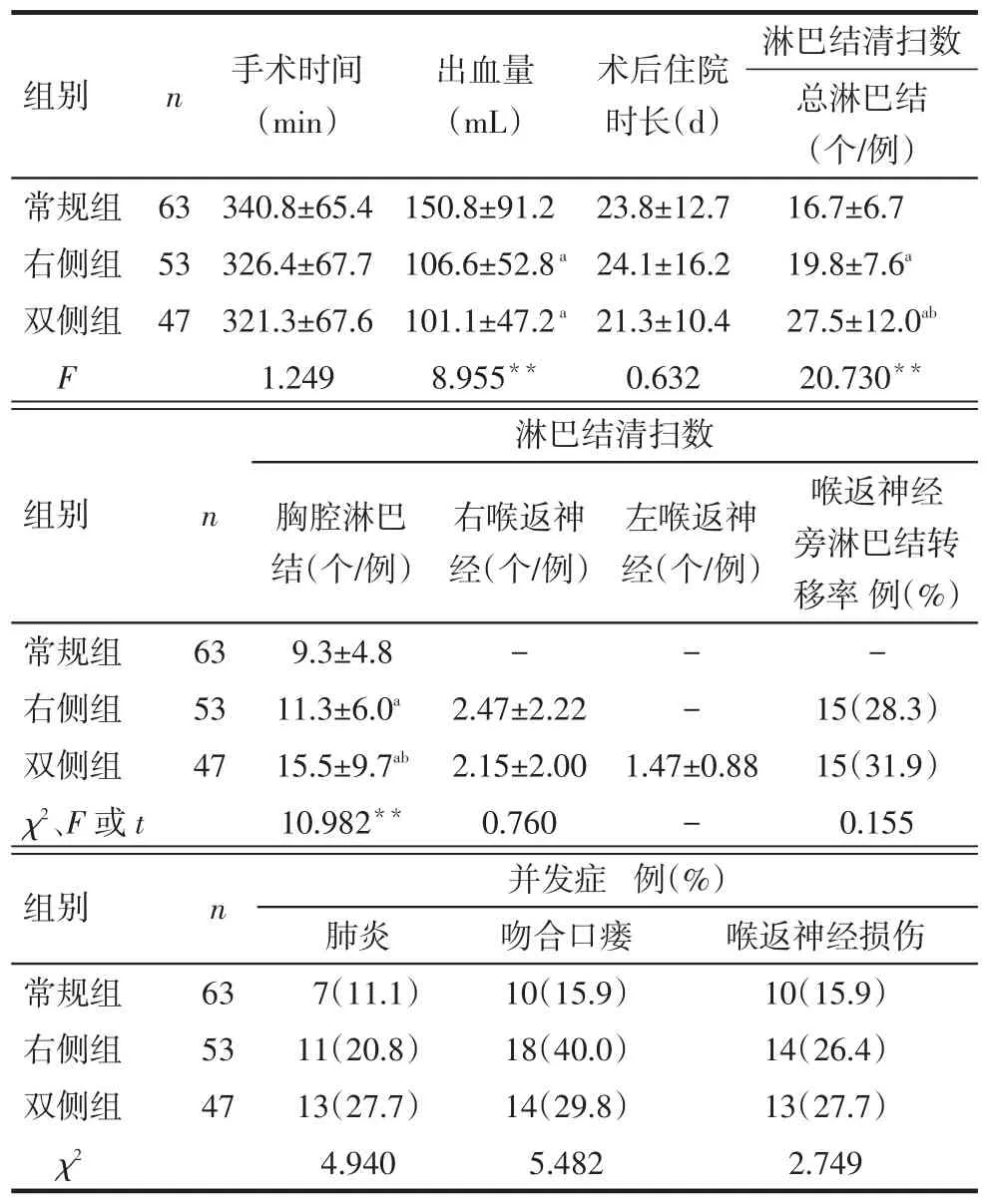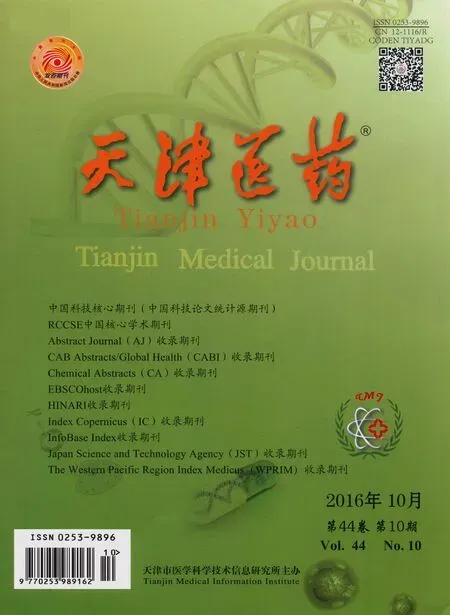微创McKeown食管癌切除术行喉返神经旁淋巴结清扫的临床效果探讨
2016-11-12薛亚斌吕红博杜同心孙伟
薛亚斌,吕红博,杜同心,孙伟
微创McKeown食管癌切除术行喉返神经旁淋巴结清扫的临床效果探讨
薛亚斌,吕红博,杜同心,孙伟△
目的探讨微创McKeown食管癌切除术行喉返神经旁淋巴结清扫的可行性、安全性。方法回顾性分析新疆医科大学附属肿瘤医院行微创McKeown食管癌切除术的食管鳞癌患者163例,依术式的不同分为常规组63例、右侧喉返神经旁淋巴结清扫组(右侧组)53例、双侧喉返神经旁淋巴结清扫组(双侧组)47例。比较各组患者术后病理情况、手术时间、术中出血量、术后住院时长、淋巴结清扫数及肺炎、吻合口瘘、喉返神经损伤等并发症情况。病理情况包括肿瘤部位、病理分化程度、T分期以及病理分期。术后并发症随访至术后6个月。结果常规组、右侧组、双侧组的肿瘤部位、病理分化程度、T分期以及病理分期差异均无统计学意义。常规组出血量大于右侧组和双侧组(P<0.05),右侧组与双侧组出血量差异无统计学意义;常规组、右侧组及双侧组的总淋巴结清扫数及胸腔淋巴结清扫数依次升高,组间多重比较差异均有统计学意义(P<0.05);而其他组间手术情况及术后并发症差异均无统计学意义。结论微创McKeown食管癌切除术行双侧喉返神经旁淋巴结清扫具有较好的安全性及可行性。
食管肿瘤;外科手术,微创性;喉返神经;淋巴结切除术;McKeown食管癌切除术
每年我国食管癌新发病例数占全球1/2以上,食管癌发病率居各类肿瘤第5位,死亡率居第4位[1-3]。目前,手术依然是治疗食管癌的首选方式。近年,腔镜辅助技术得到较快发展,其中微创食管切除手术(minimally invasive esophagectomy,MIE)具有创伤小、出血少、恢复快、并发症少和患者术后早期生活质量高等优点,得到广泛研究及应用[4-6]。有研究显示,食管癌喉返神经旁淋巴结转移率高达25.2%,严重影响食管癌术后的预后[7]。但作为MIE的一种术式,微创McKeown食管癌切除术在是否能达到根治性地完成纵隔淋巴结清扫,尤其是喉返神经旁淋巴结清扫的可行性、安全性及彻底性问题仍存在争议[8]。本文回顾性分析于我院行微创McKeown食管癌切除术的163例食管癌患者的喉返神经旁淋巴结情况,以期为临床提供参考。
1 对象与方法
1.1 研究对象选取2011年1月—2015年12月于我院胸外科行微创McKeown食管癌切除术者163例,男106例,女57例,年龄35~79岁,均于术前行胃镜病理证实为食管鳞癌,诊断标准参照食管癌规范化诊疗指南(第2版)。纳入标准:(1)术前均行胃镜活检病理诊断,术后经病理学检查确定诊断。(2)术前均行胸部及上腹部增强CT、腹部B超检查排除远处转移者。(3)行微创McKeown食管癌切除术的患者。排除标准:(1)术前T分期>T3。(2)食管胃结合部肿瘤患者。(3)杂交微创食管癌手术者。(4)由于各种原因中转为开放手术者。(5)由于术后失访导致病例资料不全者。所有患者经术前胸部平扫加增强CT均提示无明显外侵,其中有2例行术前辅助放、化疗,3例行术前DDP-5-FU[8]辅助化疗方案化疗。163例患者依术式的不同分为常规组、右侧喉返神经旁淋巴结清扫组(右侧组)、双侧喉返神经旁淋巴结清扫组(双侧组),各组年龄、性别、民族构成差异均无统计学意义(P>0.05),具有可比性,见表1。

Tab.1Comparison of general clinical data between three groups of patients表1 患者一般临床资料比较
1.2 手术方法各组术前准备与常规食管癌手术相同,患者均采用左颈、右胸及腹的食管癌手术体位。手术过程:患者采用侧腹卧位,依靠重力作用使右肺下垂并暴露后纵隔。参照文献[9]行食管和腹部胃的游离、管状胃的制作及颈部吻合。常规组淋巴结清扫包括隆突下淋巴结,食管旁淋巴结,胃小弯侧淋巴结,胃左、肝总与腹腔动脉旁淋巴结;右侧组在常规组的基础上增加右侧喉返神经旁淋巴结;双侧组在常规组基础上增加了右侧和左侧喉返神经旁淋巴结清扫。
1.3 结果观察比较各组患者术后病理情况、手术时间、术中的出血量、术后住院时长、淋巴结清扫数及并发症情况。病理情况包括肿瘤部位、病理分化程度、T分期以及病理分期。T分期主要依据食管原发肿瘤的侵润深度:Tis为重度不典型增生,T1为肿瘤侵犯黏膜固有层、黏膜肌层或者黏膜下层,T2为肿瘤侵犯食管肌层,T3为肿瘤侵犯食管纤维膜。病理分期以食管癌规范化诊疗指南(第2版)为准。喉返神经损伤诊断以术后3个月鼻咽喉镜结果为准。术后并发症随访至术后6个月,以美国胸外科医师协会(Society of Thoracic Surgery)普胸外科数据库登记表2.081版为标准[10]。1.4统计学方法采用SPSS 16.0软件进行统计分析。计数资料组间比较采用χ2检验;符合正态分布的计量资料用表示,2组间均数比较用t检验,多组间均数比较用单因素方差分析,组间多重比较用采用SNK-q检验,检验水准α= 0.05。
2 结果
2.1 各组术后病理结果差异的比较常规组、右侧组、双侧组的肿瘤部位、病理分化程度、T分期以及病理分期差异均无统计学意义,见表2。

Tab.2Pathological condition after operation in three groups表2 各组术后病理情况
2.2 各组手术情况及术后并发症的比较常规组出血量大于右侧组和双侧组(P<0.05),但右侧组与双侧组差异无统计学意义(P>0.05);常规组、右侧组及双侧组的总淋巴结清扫数及胸腔淋巴结清扫数依次升高,组间多重比较差异均有统计学意义(均P<0.05);而其他组间手术情况及术后并发症差异均无统计学意义,见表3。
3 讨论
我国食管癌以食管中段鳞癌最为常见,由于食管癌有淋巴结转移特点,中段食管鳞癌淋巴结转移好发于上纵隔喉返神经旁淋巴结[11-12],转移率可高达25.2%[7]。与西方国家常见的因反流性食管炎引起的食管下段腺癌不同,我国食管中段淋巴结转移好发于上纵隔淋巴结,所以手术方式上也有所区别,而微创McKeown食管癌切除术对于上纵隔喉返神经旁淋巴结的清扫具有优势[13-14]。然而,喉返神经旁淋巴结位于颈胸交界处,开放状态下清扫困难,且腔镜状态下由于器械与操作角度的限制,清扫该区域淋巴结时可能增加喉返神经损伤及肺部并发症发生的概率[15]。Safranek等[16]研究发现,喉返神经损伤会导致吸痰,增加呼吸系统并发症的发生率,短时间内严重影响患者生活质量。因此,本研究将患者按清扫情况分为常规组、右侧组与双侧组,对比各组术中及术后6个月的相关指标差异,以探讨喉返神经旁淋巴结清扫的可行性及安全性。
本研究结果显示,各组年龄、性别、族别、肿瘤部位差异无统计学意义,具有可比性,在术后病理方面,各组肿瘤部位,病理分化程度,T分期及病理分期差异均无统计学意义,但常规组的Ⅰ期、Ⅱ期患者达43例,较右侧组及双侧组多,提示我院在开展微创McKeown食管癌切除术的患者中以早期食管癌为主,主要考虑这在一定程度上可以降低手术难度及风险,相关研究亦显示对早期食管癌进行手术,术者可较快达到手术的学习曲线平台期[17]。
有研究显示,双侧喉返神经旁淋巴结清扫组与常规清扫组微创食管癌手术时间差异无统计学意义,而前者出血量大于后者[18]。本研究亦显示各组手术时间差异无统计学意义,与上述研究结果相近,但常规组出血量大于右侧组及双侧组,与上述研究不同,考虑原因可能为一般情况下对常规组进行手术的医师主要处于微创手术早期学习阶段,经验相对行右侧和双侧喉返神经旁淋巴结清扫的医师不足,可能导致了患者术中出血较多。本研究中各组术后住院时长和并发症差异均无统计学意义,与文献报道相似[18],分析原因可能为虽然右侧组及双侧组较常规组增加了喉返神经旁淋巴结清扫,增加了手术创伤,但未明显增加患者术后相关并发症的发生率,排除医师经验影响,说明双侧喉返神经旁淋巴结清扫具有一定的可行性和安全性。另外,双侧组总淋巴结清扫数和胸腔淋巴结清扫数高于右侧组及常规组,与Ma等[9]的研究结果基本一致,而右侧组和双侧组右喉返神经旁淋巴结清扫数差异无统计学意义,考虑原因可能为微创McKeown食管癌切除术经右侧胸腔清扫淋巴结,而右侧淋巴结与右侧喉返神经旁淋巴结毗邻,存在界限认识差异。
综上所述,微创McKeown食管癌切除术行双侧喉返神经旁淋巴结清扫相对常规清扫和右侧清扫,具有较好的安全性及可行性,然而本研究随访时间较短,长期预后情况仍需进一步研究深入。

Tab.3The complications before and after operation in three groups表3 各组患者手术及术后并发症情况
[1]Chen W,Zheng R,Zhang S,et al.Report of incidence and mortality in China cancer registries,2009[J].Chin J Cancer Res,2013,25(1):10-21.doi:10.3978/j.issn.1000-9604.2012.12.04.
[2]Jemal A,Bray F,Center MM,et al.Global cancer statistics[J].CA Cancer J Clin,2011,61(2):69-90.doi:10.3322/caac.20107.
[3]Murray CJ,Vos T,Lozano R,et al.Disability-adjusted life years(DALYs)for 291 diseases and injuries in 21 regions,1990-2010: a systematic analysis for the Global Burden of Disease Study 2010[J].Lancet,2013,380(9859):2197-2223.doi:10.1016/S0140-6736(12)61689-4.
[4]Yamamoto M,Weber JM,Karl RC,et al.Minimally invasive surgery for esophageal cancer:review of the literature and institutional experience[J].Cancer Control,2013,20(2):130-137.
[5]Anderegg MC,Gisbertz SS,van Berge Henegouwen MI.Minimally invasive surgery for oesophageal cancer[J].Best Pract Res Clin Gastroenterol,2014,28(1):41-52.doi:10.1016/j.bpg.2013.11.002.
[6]Kawakubo H,Takeuchi H,Kitagawa Y.Current status and future perspectives on minimally invasive esophagectomy[J].Korean JThorac Cardiovasc Surg,2013,46(4):241-248.doi:10.5090/ kjtcs.2013.46.4.241.
[7]Li HM,Li Y,Liu XB,et al.Patterns of lymphatic spread in thoracic esophageal squamous cell carcinoma:a study of 313 cases[J].Chin J Oncol,2015,37(11):841-844.[李浩淼,李印,刘先本,等. 313例胸段食管鳞癌患者的淋巴结转移特点[J].中华肿瘤杂志,2015,37(11):841-844].doi:10.3760/cma.j.issn.0253-3766.2015.11.009.
[8]Blum Murphy MA,Elimova E,Ajani JA.Current concepts and future potential in neoadjuvant chemotherapy for esophageal cancer[J].Expert Rev Gastroenterol Hepatol,2016,10(3):383-392. doi:10.1586/17474124.2016.1116936.
[9]Ma GW,Situ DR,Ma QL,et al.Three-field vs two-field lymph node dissection for esophageal cancer:A meta-analysis[J].World J Gastroenterol,2014,20(47):18022-18030.doi:10.3748/wjg.v20. i47.18022.
[10]Epstein AE,DiMarco JP,Ellenbogen KA,et al.ACC/AHA/HRS 2008 guidelines for device-based therapy of cardiac rhythm abnormalities:a report of the American College of Cardiology/ American Heart Association Task Force on Practice Guidelines(WritingCommitteetoRevisetheACC/AHA/NASPE2002 Guideline Update for Implantation of Cardiac Pacemakers and Antiarrhythmia Devices)developed in collaboration with the American Association for Thoracic Surgery and Society of Thoracic Surgeons[J].J Am Coll Cardiol,2008,51(21):e1-e62.doi: 10.1016/j.jacc.2008.02.032.
[11]Yang H,Wang J,Huang Q,et al.Intraoperative ultrasonography for the identification of thoracic recurrent laryngeal nerve lymph nodes in patients with esophageal cancer[J].Dis Esophagus,2015,29(2):152-158.doi:10.1111/dote.12318.
[12]Zhong D,Zhou Y,Li Y,et al.Intraoperative recurrent laryngeal nerve monitoring:a useful method for patients with esophageal cancer[J].Dis Esophagus,2014,27(5):444-451.doi:10.1111/ j.1442-2050.2012.01414.x.
[13]Zhu C,Jin K.Minimally invasive esophagectomy for esophageal cancer in the People's Republic of China:an overview[J].Onco Targets Ther,2013,6:119-124.doi:10.2147/OTT.S40667.
[14]Conteduca V,Sansonno D,Ingravallo G,et al.Barrett's esophagus and esophageal cancer:an overview[J].Int J Oncol,2012,41(2): 414-424.doi:10.3892/ijo.2012.1481.
[15]Ben-David K,Sarosi GA,Cendan JC,et al.Decreasing morbidity andmortalityin100consecutiveminimallyinvasive esophagectomies[J].Surg Endosc,2012,26(1):162-167.doi: 10.1007/s00464-011-1846-3.
[16]Safranek PM,Cubitt J,Booth MI,et al.Review of open and minimal access approaches to oesophagectomy for cancer[J].Br J Surg,2010,97(12):1845-1853.doi:10.1002/bjs.7231.
[17]Dhamija A,Rosen JE,Dhamija A,et al.Learning curve to lymph node resection in minimally invasive esophagectomy for cancer[J]. Innovations(Phila),2014,9(4):286-291.
[18]Zhang Y,Tan LJ,Feng MX,et al.Feasibility and safety of radical mediastinal lymphadenectomy in thoracoscopic esophagectomy for esophageal cancer[J].Chin J Oncol,2012,34(11):855-859.[张毅,谭黎杰,冯明祥,等.胸腔镜食管癌切除术中广泛纵隔淋巴结清扫的可行性与安全性[J].中华肿瘤杂志,2012,34(11): 855-859].doi:10.3760/cma.j.issn.0253-3766.2012.11.013.
(2016-04-26收稿2016-07-19修回)
(本文编辑陆荣展)
Feasibility and safety of McKeown-type minimally invasive esophagectomy in para-recurrent laryngeal nerve lymphadenectomy
XUE Yabin,LYU Hongbo,DU Tongxin,SUN Wei△
Thoracic Surgery,the Affiliated Tumor Hospital of Xinjiang Medical University,Urumqi 830001,China△
ObjectiveTo explore the feasibility and safety of Mckeown-type minimally invasive esophagectomy in para-recurrent laryngeal nerve lymphadenectomy.MethodsA total of 163 cases underwent minimally invasive McKeown resection for esophageal carcinoma in the Affiliated Tumor Hospital of Xinjiang Medical University were retrospectively analyzed.Patients were divided into routine treatment group(n=63),right recurrent nerve lymph node dissection group(right group,n=53)and bilateral recurrent laryngeal nerve lymph node dissection group(bilateral group,n=47)according to the operation modes.The postoperative pathology,operation time,intraoperative bleeding volume,postoperative hospitalization time,number of lymph nodes and pneumonia,anastomotic fistula,laryngeal nerve injury and other complications were compared between three groups of patients.Pathological conditions were consisted of the location of tumor,the degree of differentiation,T stage and pathological stage.Postoperative complications were followed up for 6 months.ResultsThere were no significant differences in tumor location,pathological differentiation degree,T stage and pathologic stage between three groups.The amount of bleeding was more in the routine group than that of the right group and the bilateral group(P<0.05).There was no significant difference in the amount of bleeding between the right group and the bilateral group.The total lymph nodes and thoracic lymph nodes were increased in order in routine group,the right group and the bilateral group,and there was significant difference between three groups(P<0.05).There were no significant differences in other operation data and complications between three groups.ConclusionMcKeown-type minimally invasive esophagectomy shows good feasibility and safety for para-recurrent laryngeal nerve lymphadenectomy.
esophagealneoplasms;surgicalprocedures,minimallyinvasive;recurrentlaryngealnerve;lymphadenectomy;Mckeown-type minimally invasive esophagectomy
R735.1
A
10.11958/20160351
新疆医科大学附属肿瘤医院胸外科(邮编830001)
薛亚斌(1990),男,硕士在读,主要从事食管癌及肺癌的临床与基础研究
△通讯作者E-mail:sunw69@163.com
